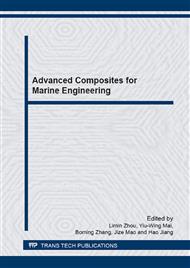p.35
p.43
p.54
p.63
p.72
p.78
p.85
p.94
p.102
Real-Time Impact Monitoring of Composites for Ship Applications
Abstract:
Composites are getting more and more attention in the usage of major structures on ships owing to many advantages such as high specific strength and rigidity. However, composites are sensitive to impact, which indicates that the load-carrying capacity and stability of composite structures will decrease dramatically even for an invisible impact damage. Hence, a real-time impact monitoring system which has already been applied in aviation industry is important for reliability of ships, which inevitably encounter impacts during their lifetime due to different sources. This paper deals with the realization of an operational processing scheme to monitor the impact on composite structures, and estimate the impact location and load history by power distribution approach and system identification method. A PZT (piezoelectric lead zirconate titanate) sensor network was designed and employed to collect sensing signals for monitoring the impact. In the monitoring process, stress wave signals caused by impact were captured, and used to determine the impacted location and load history. Results demonstrate that the proposed method can be successfully applied in identifying the location and load history of impact on composite structures. The impact identification approach is of great significance for marine applications.
Info:
Periodical:
Pages:
72-77
Citation:
Online since:
March 2015
Authors:
Keywords:
Price:
Сopyright:
© 2015 Trans Tech Publications Ltd. All Rights Reserved
Share:
Citation:


